Zhixin Ling
OneRec-V2 Technical Report
Aug 28, 2025Abstract:Recent breakthroughs in generative AI have transformed recommender systems through end-to-end generation. OneRec reformulates recommendation as an autoregressive generation task, achieving high Model FLOPs Utilization. While OneRec-V1 has shown significant empirical success in real-world deployment, two critical challenges hinder its scalability and performance: (1) inefficient computational allocation where 97.66% of resources are consumed by sequence encoding rather than generation, and (2) limitations in reinforcement learning relying solely on reward models. To address these challenges, we propose OneRec-V2, featuring: (1) Lazy Decoder-Only Architecture: Eliminates encoder bottlenecks, reducing total computation by 94% and training resources by 90%, enabling successful scaling to 8B parameters. (2) Preference Alignment with Real-World User Interactions: Incorporates Duration-Aware Reward Shaping and Adaptive Ratio Clipping to better align with user preferences using real-world feedback. Extensive A/B tests on Kuaishou demonstrate OneRec-V2's effectiveness, improving App Stay Time by 0.467%/0.741% while balancing multi-objective recommendations. This work advances generative recommendation scalability and alignment with real-world feedback, representing a step forward in the development of end-to-end recommender systems.
Kwai Keye-VL Technical Report
Jul 02, 2025Abstract:While Multimodal Large Language Models (MLLMs) demonstrate remarkable capabilities on static images, they often fall short in comprehending dynamic, information-dense short-form videos, a dominant medium in today's digital landscape. To bridge this gap, we introduce \textbf{Kwai Keye-VL}, an 8-billion-parameter multimodal foundation model engineered for leading-edge performance in short-video understanding while maintaining robust general-purpose vision-language abilities. The development of Keye-VL rests on two core pillars: a massive, high-quality dataset exceeding 600 billion tokens with a strong emphasis on video, and an innovative training recipe. This recipe features a four-stage pre-training process for solid vision-language alignment, followed by a meticulous two-phase post-training process. The first post-training stage enhances foundational capabilities like instruction following, while the second phase focuses on stimulating advanced reasoning. In this second phase, a key innovation is our five-mode ``cold-start'' data mixture, which includes ``thinking'', ``non-thinking'', ``auto-think'', ``think with image'', and high-quality video data. This mixture teaches the model to decide when and how to reason. Subsequent reinforcement learning (RL) and alignment steps further enhance these reasoning capabilities and correct abnormal model behaviors, such as repetitive outputs. To validate our approach, we conduct extensive evaluations, showing that Keye-VL achieves state-of-the-art results on public video benchmarks and remains highly competitive on general image-based tasks (Figure 1). Furthermore, we develop and release the \textbf{KC-MMBench}, a new benchmark tailored for real-world short-video scenarios, where Keye-VL shows a significant advantage.
Short Video Segment-level User Dynamic Interests Modeling in Personalized Recommendation
Apr 05, 2025



Abstract:The rapid growth of short videos has necessitated effective recommender systems to match users with content tailored to their evolving preferences. Current video recommendation models primarily treat each video as a whole, overlooking the dynamic nature of user preferences with specific video segments. In contrast, our research focuses on segment-level user interest modeling, which is crucial for understanding how users' preferences evolve during video browsing. To capture users' dynamic segment interests, we propose an innovative model that integrates a hybrid representation module, a multi-modal user-video encoder, and a segment interest decoder. Our model addresses the challenges of capturing dynamic interest patterns, missing segment-level labels, and fusing different modalities, achieving precise segment-level interest prediction. We present two downstream tasks to evaluate the effectiveness of our segment interest modeling approach: video-skip prediction and short video recommendation. Our experiments on real-world short video datasets with diverse modalities show promising results on both tasks. It demonstrates that segment-level interest modeling brings a deep understanding of user engagement and enhances video recommendations. We also release a unique dataset that includes segment-level video data and diverse user behaviors, enabling further research in segment-level interest modeling. This work pioneers a novel perspective on understanding user segment-level preference, offering the potential for more personalized and engaging short video experiences.
PanoSwin: a Pano-style Swin Transformer for Panorama Understanding
Aug 28, 2023



Abstract:In panorama understanding, the widely used equirectangular projection (ERP) entails boundary discontinuity and spatial distortion. It severely deteriorates the conventional CNNs and vision Transformers on panoramas. In this paper, we propose a simple yet effective architecture named PanoSwin to learn panorama representations with ERP. To deal with the challenges brought by equirectangular projection, we explore a pano-style shift windowing scheme and novel pitch attention to address the boundary discontinuity and the spatial distortion, respectively. Besides, based on spherical distance and Cartesian coordinates, we adapt absolute positional embeddings and relative positional biases for panoramas to enhance panoramic geometry information. Realizing that planar image understanding might share some common knowledge with panorama understanding, we devise a novel two-stage learning framework to facilitate knowledge transfer from the planar images to panoramas. We conduct experiments against the state-of-the-art on various panoramic tasks, i.e., panoramic object detection, panoramic classification, and panoramic layout estimation. The experimental results demonstrate the effectiveness of PanoSwin in panorama understanding.
Few-shot Single-view 3D Reconstruction with Memory Prior Contrastive Network
Jul 30, 2022



Abstract:3D reconstruction of novel categories based on few-shot learning is appealing in real-world applications and attracts increasing research interests. Previous approaches mainly focus on how to design shape prior models for different categories. Their performance on unseen categories is not very competitive. In this paper, we present a Memory Prior Contrastive Network (MPCN) that can store shape prior knowledge in a few-shot learning based 3D reconstruction framework. With the shape memory, a multi-head attention module is proposed to capture different parts of a candidate shape prior and fuse these parts together to guide 3D reconstruction of novel categories. Besides, we introduce a 3D-aware contrastive learning method, which can not only complement the retrieval accuracy of memory network, but also better organize image features for downstream tasks. Compared with previous few-shot 3D reconstruction methods, MPCN can handle the inter-class variability without category annotations. Experimental results on a benchmark synthetic dataset and the Pascal3D+ real-world dataset show that our model outperforms the current state-of-the-art methods significantly.
Bi-Directional Domain Translation for Zero-Shot Sketch-Based Image Retrieval
Nov 29, 2019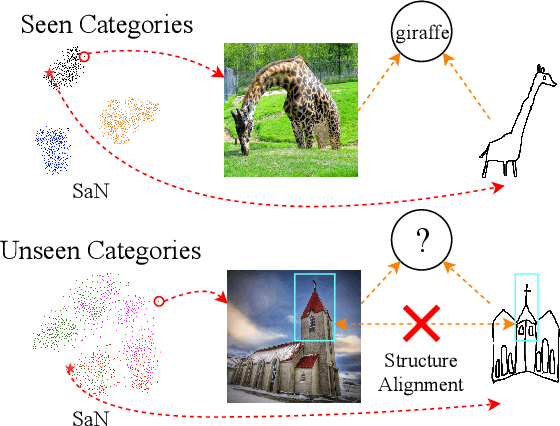
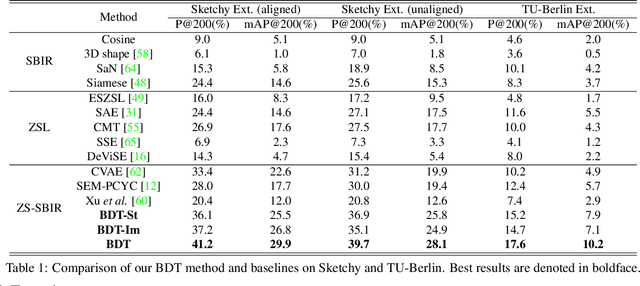
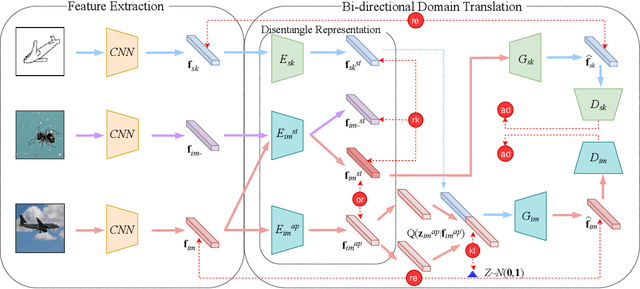
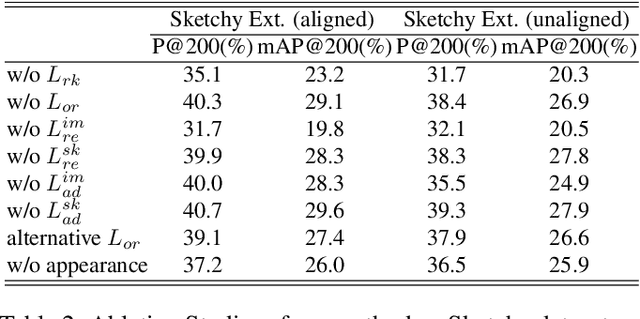
Abstract:The goal of Sketch-Based Image Retrieval (SBIR) is using free-hand sketches to retrieve images of the same category from a natural image gallery. However, SBIR requires all categories to be seen during training, which cannot be guaranteed in real-world applications. So we investigate more challenging Zero-Shot SBIR (ZS-SBIR), in which test categories do not appear in the training stage. Traditional SBIR methods are prone to be category-based retrieval and cannot generalize well from seen categories to unseen ones. In contrast, we disentangle image features into structure features and appearance features to facilitate structure-based retrieval. To assist feature disentanglement and take full advantage of disentangled information, we propose a Bi-directional Domain Translation (BDT) framework for ZS-SBIR, in which the image domain and sketch domain can be translated to each other through disentangled structure and appearance features. Finally, we perform retrieval in both structure feature space and image feature space. Extensive experiments demonstrate that our proposed approach remarkably outperforms state-of-the-art approaches by about 8% on the Sketchy dataset and over 5% on the TU-Berlin dataset.
Deep Image Harmonization via Domain Verification
Nov 27, 2019



Abstract:Image composition is an important operation in image processing, but the inconsistency between foreground and background significantly degrades the quality of composite image. Image harmonization, aiming to make the foreground compatible with the background, is a promising yet challenging task. However, the lack of high-quality publicly available dataset for image harmonization greatly hinders the development of image harmonization techniques. In this work, we contribute an image harmonization dataset by generating synthesized composite images based on COCO (resp., Adobe5k, Flickr, day2night) dataset, leading to our HCOCO (resp., HAdobe5k, HFlickr, Hday2night) sub-dataset. Moreover, we propose a new deep image harmonization method with a novel domain verification discriminator, enlightened by the following insight. Specifically, incompatible foreground and background belong to two different domains, so we need to translate the domain of foreground to the same domain as background. Our proposed domain verification discriminator can play such a role by pulling close the domains of foreground and background. Extensive experiments on our constructed dataset demonstrate the effectiveness of our proposed method. Our dataset is released in https://github.com/bcmi/Image_Harmonization_Datasets.
Image Harmonization Datasets: HCOCO, HAdobe5k, HFlickr, and Hday2night
Aug 28, 2019

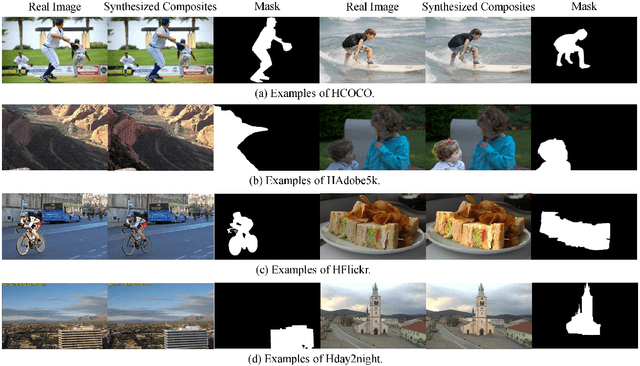
Abstract:Image composition is an important operation in image processing, but the inconsistency between foreground and background significantly degrades the quality of composite image. Image harmonization, which aims to make the foreground compatible with the background, is a promising yet challenging task. However, the lack of high-quality public dataset for image harmonization, which significantly hinders the development of image harmonization techniques. Therefore, we create synthesized composite images based on existing COCO (resp., Adobe5k, day2night) dataset, leading to our HCOCO (resp., HAdobe5k, Hday2night) dataset. To enrich the diversity of our datasets, we also generate synthesized composite images based on our collected Flick images, leading to our HFlickr dataset. All four datasets are released in https://github.com/bcmi/Image_Harmonization_Datasets.
 Add to Chrome
Add to Chrome Add to Firefox
Add to Firefox Add to Edge
Add to Edge